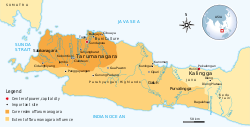This article needs additional citations for verification. (November 2012) |
State of Taruma ᮒᮛᮥᮙᮔᮌᮛ Tarumanagara | |||||||||||
|---|---|---|---|---|---|---|---|---|---|---|---|
| ca. 358–669 | |||||||||||
 The territory of Tarumanagara | |||||||||||
| Capital | Sundapura (between North Jakarta and Bekasi Regency) | ||||||||||
| Common languages | Old Sundanese, Sanskrit | ||||||||||
| Religion | Hinduism, Buddhism, Animism, Sunda Wiwitan | ||||||||||
| Government | Monarchy | ||||||||||
| History | |||||||||||
• Established | ca. 358 | ||||||||||
• Invasion of Sriwijaya | 669 | ||||||||||
| |||||||||||
| Today part of | Indonesia | ||||||||||
| History of Indonesia |
|---|
 |
| Timeline |
|
|
Tarumanagara or Taruma Kingdom or just Taruma was an early Sundanese Indianised kingdom[broken anchor], located in western Java, whose 5th-century ruler, Purnawarman, produced the earliest known inscriptions in Java, which are estimated to date from around 358 CE.[1]
At least seven stone inscriptions connected to this kingdom were discovered in Western Java area, near Bogor and Jakarta. They are Ciaruteun, Kebon Kopi, Jambu, Pasir Awi, and Muara Cianten inscriptions near Bogor; Tugu inscription near Cilincing in North Jakarta; and Cidanghiang inscription in Lebak village, Munjul district, south of Banten.[2]: 36
- ^ Iguchi, Masatoshi (28 January 2015). Java Essay: The History and Culture of a Southern Country. Troubador Publishing Ltd. ISBN 978-1-78462-151-3.
- ^ R. Soekmono (1988) [1973]. Pengantar Sejarah Kebudayaan Indonesia 2, 2nd ed (in Indonesian) (5th reprint ed.). Yogyakarta: Penerbit Kanisius.